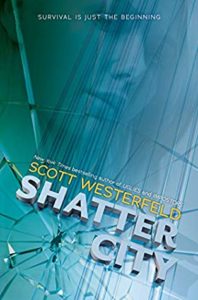
Shatter City (Imposters #2)
Scott Westerfeld
Scholastic
Published September 17, 2019
Amazon | Barnes & Noble | Book Depository | Goodreads
About Shatter City
When the world sees Frey, they think they see her twin sister Rafi. Frey was raised to be Rafi’s double, and now she’s taken on the role . . . without anyone else knowing.
Her goal? To destroy the forces that created her.
But with the world watching and a rebellion rising, Frey is forced into a detour. Suddenly she is stranded on her own in Paz, a city where many of the citizens attempt to regulate their emotions through an interface on their arms. Paz is an easy place to get lost . . . and also an easy place to lose yourself.
As the city comes under a catastrophic attack, Frey must leave the shadows and enter the chaos of warfare – because there is no other way for her to find her missing sister and have her revenge against her murderous father.
My Review
It’s been a long time since I’ve read anything by Scott Westerfeld, and SHATTER CITY made me realize how silly that is. I LOVE his books! It’s so easy to connect with the characters and the internal struggle that Frey faced in wanting to be herself but continually finding herself stuck impersonating her sister.
I also really enjoyed the references to the Uglies series, which I also loved reading. It felt like sharing inside knowledge with Frey. (You can read this series without ever reading UGLIES. The references aren’t critical to the story.)
One interesting element in the story happens when Frey visits a city called Paz. While she’s mistaken for her sister, she undergoes surgery to have “feels” installed. These are buttons on her inner forearm that trigger different emotions when she presses them.
At first, Frey thinks they’re weird and stupid and that she’d never use them. But as she experiences difficult and traumatic situations, her thoughts about the Feels experience a shift. When she finds herself again surrounded by people without the Feels, she experiences another shift. I found that process interesting. It reminded me of the way we tend to judge people– perhaps especially people with mental health issues who take medication– who make choices we can’t imagine making for ourselves. But then when we find ourselves in the same situation, we make the very choice that seemed to unimaginable before.
I don’t think the Feels are supposed to represent medication or be a metaphor for that, though the topic of Feels as a remedy for depression does come up in the story. It just made me think of the way we sometimes judge others who live a different way than we do.
I really liked this book, and definitely recommend it. I think fans of THE HUNGER GAMES and MATCHED by Ally Condie will love it.
Content Notes
Recommended for Ages 12 up.
Representation
One minor character is nonbinary. Another minor character is gay.
Profanity/Crude Language Content
None.
Romance/Sexual Content
Brief kissing between boy and girl.
Spiritual Content
None.
Violent Content
Situations of peril and some battle violence.
Drug Content
None.
Note: This post contains affiliate links, which do not cost you anything to use, but which help support the costs of running this blog. I received a free copy of SHATTER CITY in exchange for my honest review.